
How to Get the Most Out of Your RV Outdoor Kitchen Setup
How to Get the Most Out of Your RV Outdoor Kitchen Setup
Practical tips for a great experience cooking outdoors!
By: Brittany Highland
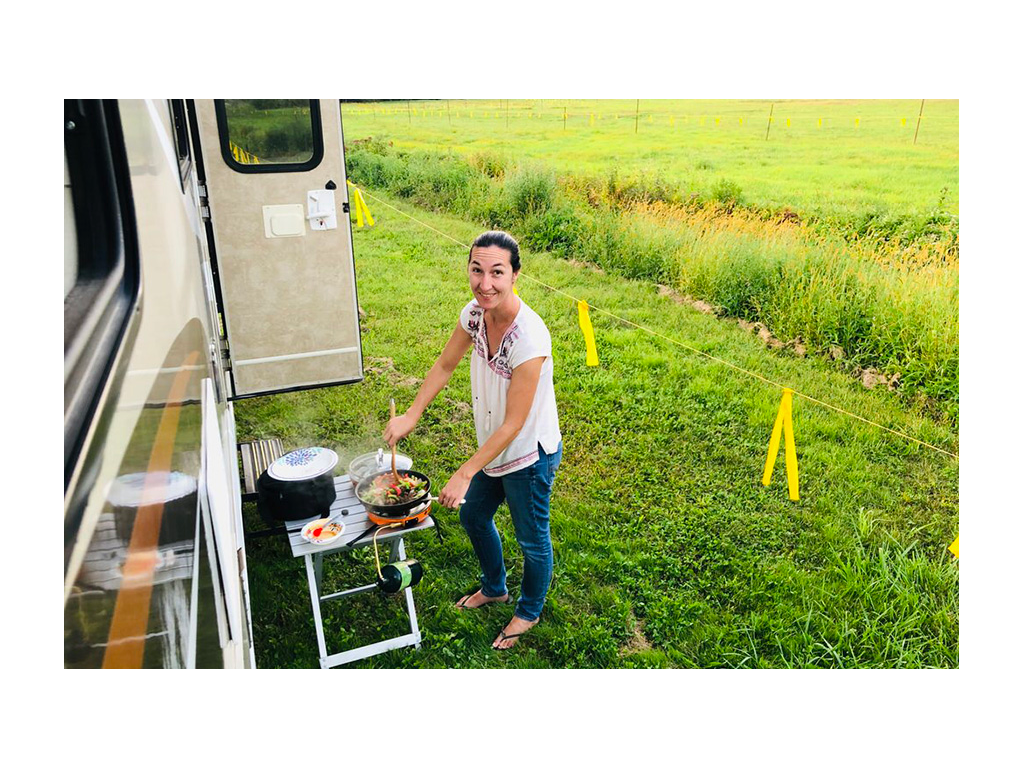
With more than six years of full-time RV travel behind us, we value this lifestyle for its flexibility. Travel fast or slow. Spend more money or less money. Dive into urban life or escape to the middle of nowhere. Another way RVers can mix it up, adapting to their current environment, is by learning to cook outdoors in a way that’s efficient and enjoyable.
Why Cook Outside When My RV Has a Kitchen?
Before getting into the what’s and how’s of setting up an outdoor kitchen, let’s get something out of the way. Why cook outdoors when there’s a fully equipped kitchen inside your RV?
Simply put, you don’t ever have to cook outside if you don’t want to. Just like many people don’t have a grill in their backyard (and many others buy a grill but never use it), you CAN cook exclusively inside your RV.
But there are several reasons why you might want to cook outside. First, strong cooking smells quickly fill the small space, and grease from one small frying pan can quickly coat half of your living area if you’re not careful. By moving your kitchen outside, you don’t have to worry about odors or grease.
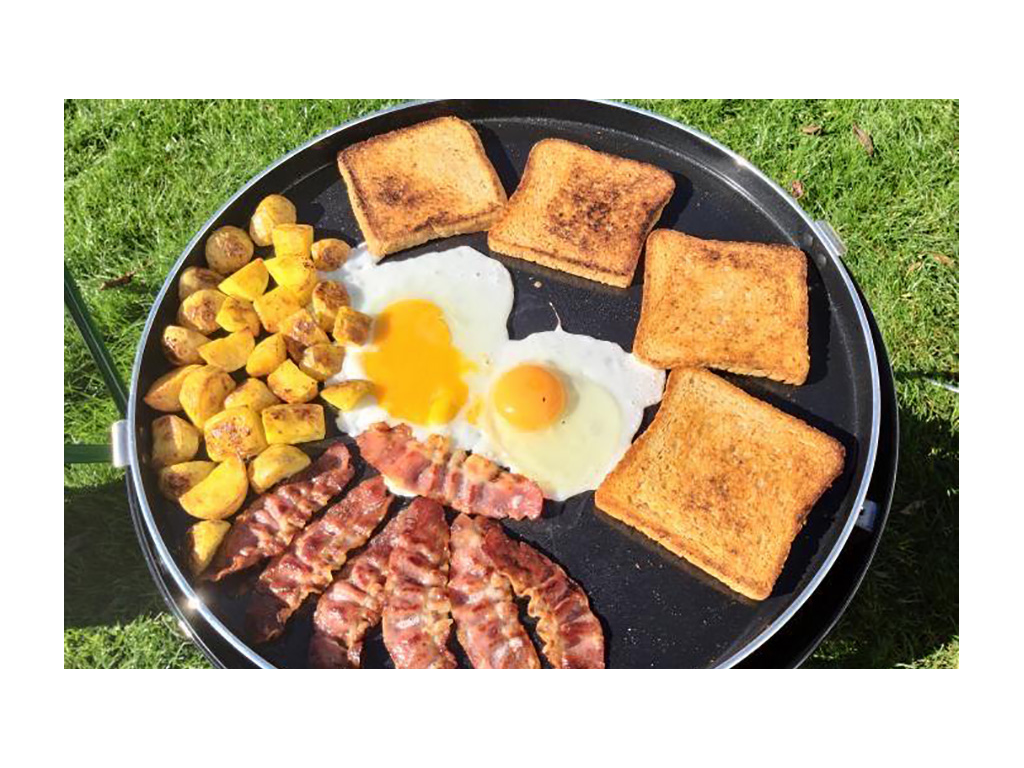
Photo Credit: @rvmanvyi
Second, if you set your outdoor kitchen up properly, you can have a larger physical space for cooking. Many small RVs lack counter space inside, an intrinsic part of tiny living. But this issue is easy to overcome outdoors with a folding table that collapses during travel. No more food prep on the desk next to your laptop or the bathroom counter!
Third, and most obviously, an outdoor kitchen gives you the opportunity to enjoy your natural surroundings. Many new RVers think they’re going to spend all their time outdoors, until the work calls stack up and Netflix beckons. But because we all have to eat, taking your meals outdoors is one way you can get into nature--even on busy days.
A Warning Before You Buy
If your interest is piqued and you’ve decided to create a kitchen outside your RV, let’s pause a second before you make your shopping list.
As you select your cooking source, utensils, and gadgets, ask yourself the following questions:
- How heavy is this item? Your RV has a manufacturer-designated payload rating. This is a number in pounds of how much cargo your unit can safely carry. You can take your packed RV to a scale at a truck stop, and within minutes you’ll know its weight. It usually costs $10 to weigh your RV. After including the weight of your family members, you’ll know how much wiggle room you have before you reach payload. This is a good step to take before beginning a new project--like setting up an outdoor kitchen--which will add to your cargo weight.
- Do I have the storage space? Check the dimensions of items like stoves, propane bottles, folding tables, and chairs, to make sure you know the footprint they’ll take up. Once you know the dimensions, look at your storage space and make sure you know exactly where the item will fit on travel days.
- Can this item serve more than one purpose? When choosing items for your outdoor kitchen, consider whether you can use the same items while backpacking or back country camping, or even cooking inside your RV. The more uses an item has, the more easily you can justify the space it will require.
Eventually, you can get in the habit of asking these questions about anything you buy for your RV. Especially for those of us who travel full-time, this quick analysis can save a lot of money and even heartache in the long run.
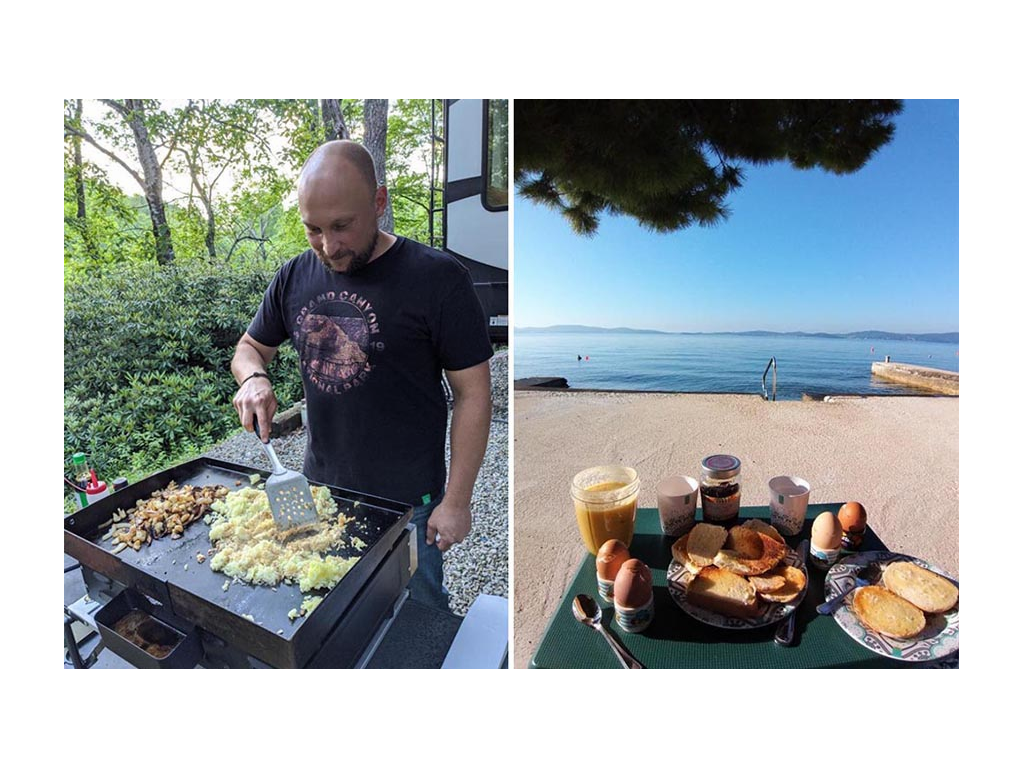
Photo Credit: @gypsies.at.heart & @rvmanvyi
What Do RVers Absolutely Need in an Outdoor Kitchen?
It’s easy to get carried away with your shopping list if you start by browsing Instagram. The reality is you need very little to have a successful outdoor cooking experience. Backpackers proved that a long time ago.
Before getting fancy, make sure you have the necessities covered:
- Heat source with fuel
- Cooking surface
- Cooking utensils
Let’s go over each category in detail.
Need #1: Heat Source with Fuel
In order to cook, you need a heat source, typically some kind of stove or grill, along with the fuel that powers it.
There are so many heat sources that it’s impossible to cover them all in one article. But the categories can generally be broken down into these five:
- Camping stoves, which may run on propane, butane, or charcoal
- Cooktops (induction is popular among RVers)
- Portable grills, which can usually run on large or small propane canisters
- Skottles, disk-shaped, shallow woks that originated in South Africa and can be used as grills or frying pans
- Campfires, for which you’ll need firewood
Each category has pros and cons, but it really comes down to you as an individual. What meals do you like to make, and how easy do you want the process to be?
For example, you may crave the traditional camping experience of a Dutch oven over a campfire. This is a wonderful experience, but it won’t always be an option due to local fire bans, or the inability to find firewood. (Note: Avoid transporting wood from one location to another because you could be moving invasive species with you).
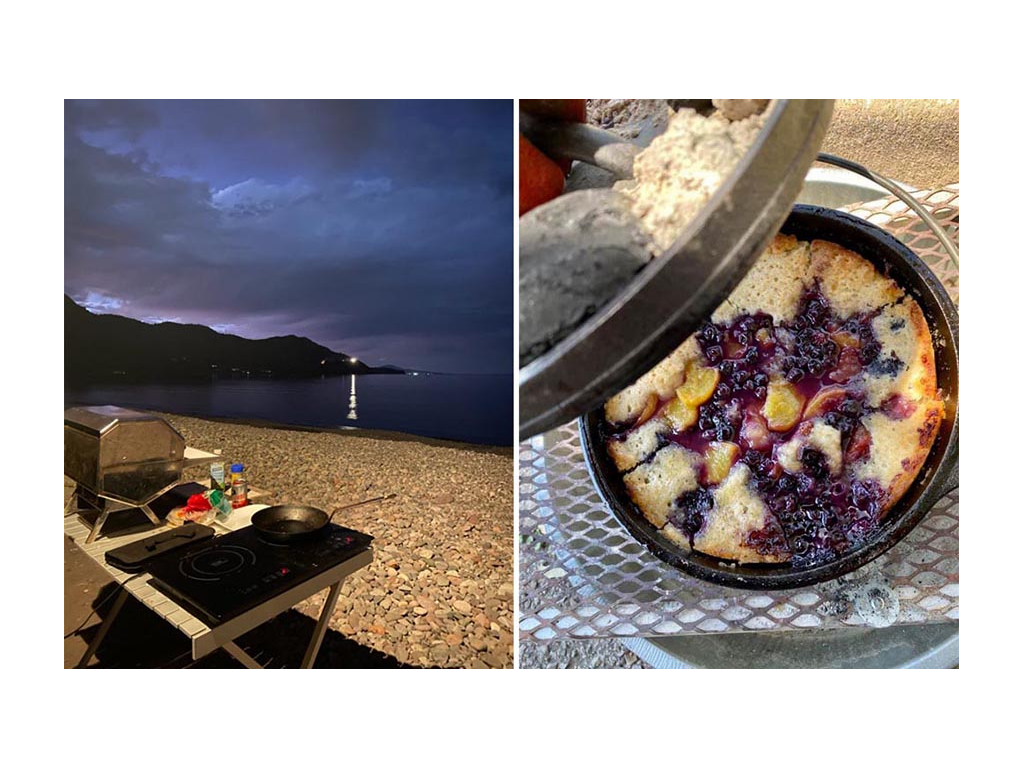
Induction cooktop setup by @endlessplaytime & Dutch oven with peachberry cobbler by @ownlessdomore.us
Or as another example, portable grills are amazing. We traveled with the Weber Q2200 for years, grilling everything from steaks to pizza. But this grill is heavy and takes up a lot of space. We left ours behind when we downsized from a 40-foot RV to our 25-foot Winnebago View, simply because we didn’t have the storage space anymore.
We now travel with the Jetboil Genesis Basecamp System, which is a two-burner, propane stove designed for backpacking and camping. It weighs only nine pounds and stores in a bag that’s 8.5" x 10.75". Because we also use it when living out of our Jeep internationally, weight, space, and reliability are our most important factors.
Research each heat source listed above, and it should become obvious which one is right for your preferences. I recommend you start with the option that best allows you to make the meals you already enjoy cooking.
Need #2: Cooking Surface
This need is less complicated. Now that you’ve chosen your cooking method, you need a surface to set it on. Most often, this will be a fold-out table. All you have to decide is what height you want the table to be, and how large it needs to be to allow you to prep and cook comfortably.
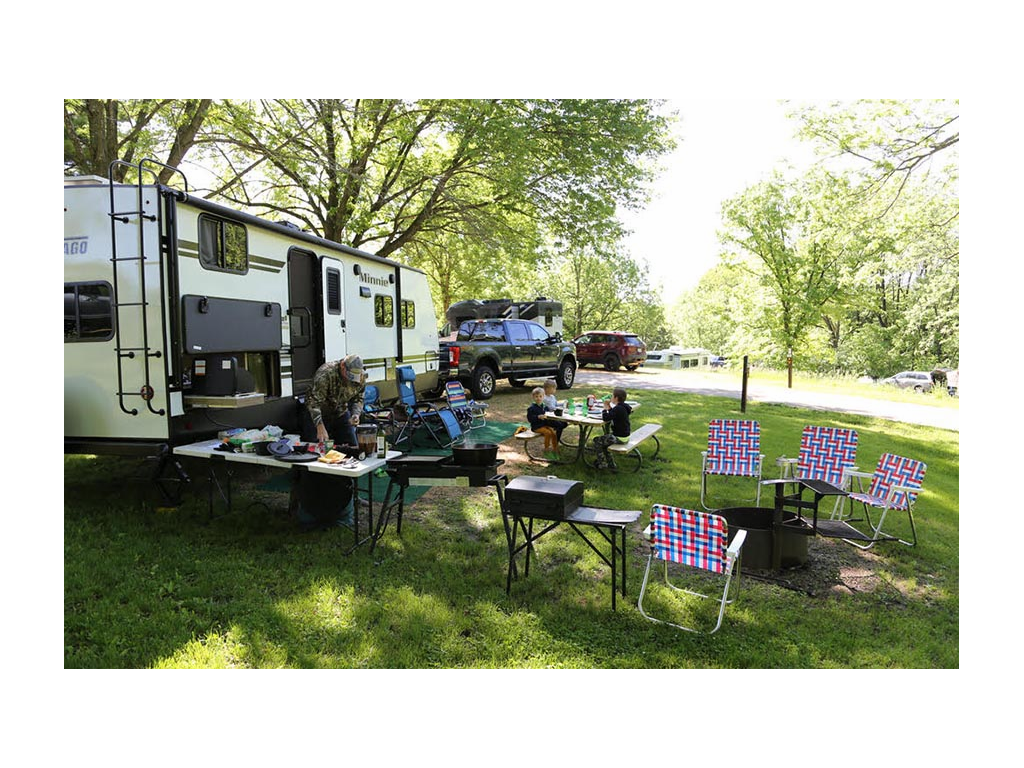
Photo Credit: @woodenshoesonwheels
You can try to rely on picnic tables, which are available at many campgrounds. However, picnic tables won’t always be available, and it would be a shame to cancel your outdoor cooking just because you don’t have a table to use.
Need #3: Cooking Utensils
For most meals, the normal cooking utensils you use inside your RV should do just fine. If you decide to buy duplicates for outside, then consider backpacking gear. It tends to be lightweight and durable.
Beyond that, if you’re grilling over high heat or fire, then you will want to invest in grill tools. That plastic spatula from inside will not be up to the task!
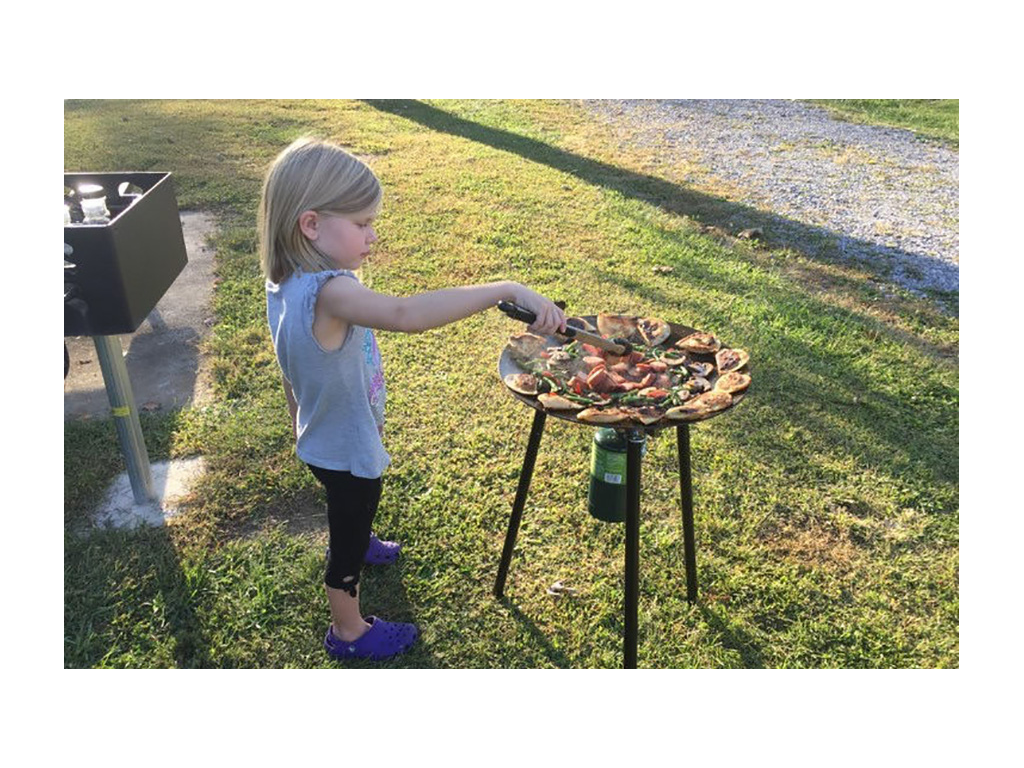
Cooking on the Skottle. Photo credit: @overlandpathfinders.
And What About Fancy Gadgets for Outdoor Cooking?
I’m sure we could swap stories of the fancy cooking gadgets we’ve seen at campgrounds. I’ve seen people with meat smokers, and I’ve been the person with an infrared turkey fryer in the basement of my RV. Some things you just can’t give up when you hit the road.
To all this I say: if you have the payload capacity and storage space, and you’re actually going to use the gadget, then go for it. No reason not to enjoy this adventure we’re on.
Buy It Built-in!
If you already know you love cooking outside, then consider purchasing an RV model that has your dream outdoor kitchen built-in. The Winnebago Minnie travel trailer, models 2201MB, 2455BHS, 2301BHS, and 2801BHS, all have put-out cooktops outside with a dual-burner stove and sink. The 2455BHS, 2301BHS, and 2801BHS also have exterior refrigerators!
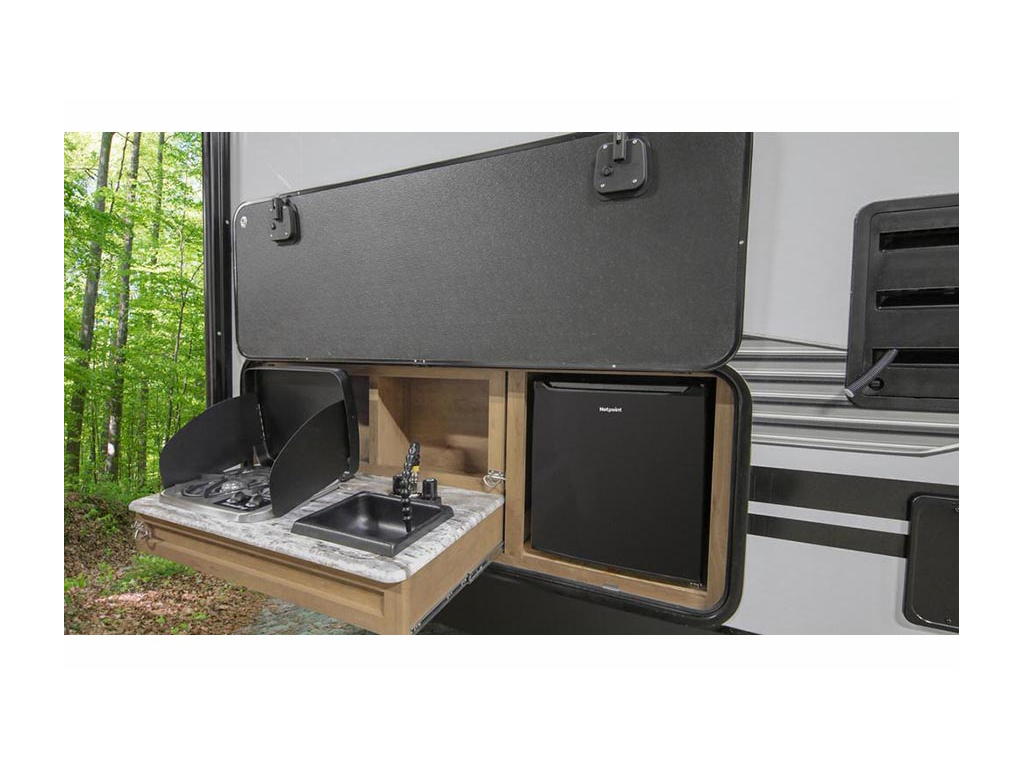
This set-up means you won’t even think twice before stepping outside to make your meal. From experience, I believe the key is to make the process as simple as possible. The more difficult it is, the less you’ll end up actually doing it.
Make the Most Out of Your Outdoor Kitchen Setup!
I hope you will give outdoor cooking a try. There’s something about sitting out in nature with my family, enjoying a hot meal, that makes me feel like I’m achieving the life I dreamed of when I first started RVing.
But don’t make it complicated. Start small and simple and learn what works best for you. Bon Appetit!
Comments
Comments on this post are moderated, so they will not appear instantly. All relevant questions and helpful notes are welcome! If you have a service inquiry or question related to your RV, please reach out to the customer care team directly using the phone numbers or contact form on this page .